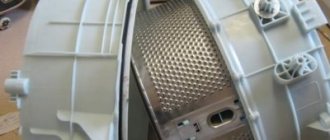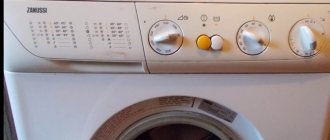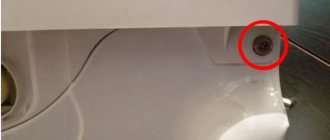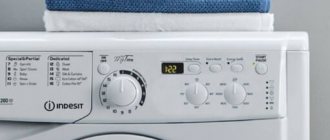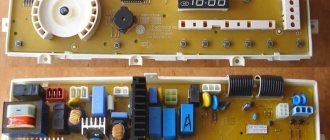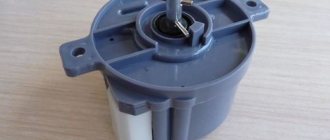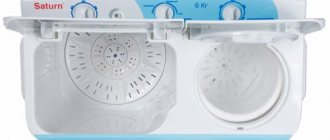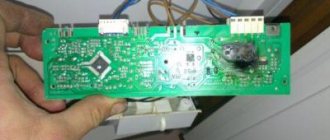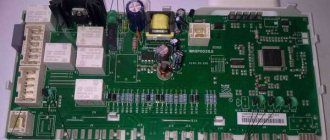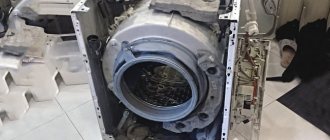The service life of the Whirlpool washing machine is 10 years, but the warranty is only 1 year. If, 365 days after purchase, any component breaks down, you will have to repair the device at your own expense.
However, this process is not as complicated as it may seem. You can deal with some malfunctions on your own, since all modern models of Whirlpool washing machines are equipped with a self-diagnosis function.
Read the article on how to recognize a breakdown, what could cause it, and how to repair a Whirlpool washing machine.
What parts most often fail in a Whirlpool washing machine?
Most often, parts that bear the maximum load fail. They are involved in every washing process, performing the main work. First of all, this concerns the heating element, control board, motor and brushes.
heating element
If the heating element malfunctions, the following code will be displayed on the screen:
- F08,
- F12,
- F22.
The main sign of a breakdown is the lack of heating of water. At the same time, the washing machine itself can work properly, performing washing.
Reasons for failure:
- Poor wiring or loose contacts.
- Burnout of the heating filament.
- Changes in the network.
- Malfunction of other systems, for example, the temperature controller, due to which the heater worked at the limit of its capabilities.
Repair:
- Inspect the condition of the wiring and the tightness of the wires.
- Check the integrity of the temperature sensor.
- Inspect the heating element, measure the voltage. If it is 20-40 Ohms, you can deal with the problem by cleaning the heater from scale.
- Reboot the device. Sometimes the cause of malfunctions in a part is a failure of the control board.
If the above actions do not help restore the functioning of the part, the heating element is changed. Details are in this article.
Electronic module
If the control board breaks down, the machine stops working or executes commands that were not specified by the user. In this case, the code F16 or F15 will be displayed on the screen.
Reasons that lead to control board failure:
- power surges;
- violation of the integrity of the wiring, loose contacts;
- water entering the electronic module;
- system failure;
- improper use of the device.
Troubleshooting methods:
- restart the washing machine;
- inspect the wires leading to the board;
- clean it from dust and carbon deposits, if any;
- flash the board;
- resolder burnt tracks, replace faulty capacitors.
If these measures do not help, repair the board.
Water level sensor
A small sensor called a pressure switch is responsible for determining the water level in the tank. If it breaks down, code F01 (FH) or F08 is displayed on the screen, and when the wash starts, water does not enter the tank, or an insufficient amount of it is collected.
Causes of malfunction:
- Intake filter clogged.
- Hose rupture.
- Violation of the integrity of the wires leading to the pressure switch.
- Pressostat failure.
To fix the problem, you need to take the following measures:
- Check to see if water is entering the machine. The tap on the water pipe may be turned off.
- Assess the condition of the inlet filter. If a blockage is found, it is cleared.
- Inspect the pressure switch, blow out the tube, check the tightness of the contacts.
If the above measures are ineffective, the sensor is replaced.
Cross
The cross is an element of the tank-drum system. If it breaks, the drum does not rotate or rotates very slowly. This process may be accompanied by grinding and knocking noises, and code F06, F26 or F28 is displayed on the screen.
Reasons leading to crosspiece failure:
- bearing wear;
- constant overload of the SMA;
- manufacturing defects;
- hard water and avoiding the use of water softeners.
The crosspiece cannot be repaired. If it is bent or cracked, it will have to be replaced. To do this, the Whirlpool washing machine must be completely disassembled.
Belt
Lack of drum rotation is the first sign indicating problems with the belt. It may fly off, stretch or tear. This stops washing, but the noise of the motor may be heard. Codes that are displayed on the screen: F06, F26 or F28.
Reasons leading to violation of the integrity of the belt:
- Weight overload of the SMA.
- Wear of bearings, shaft, crosspiece. These breakdowns cause the drum to swing violently when rotating and the belt to stretch.
- Loose motor mount.
- Drum deformation.
If the belt simply falls off, it is thrown onto the drum. If an element breaks or stretches, replacement is required.
Hatch handle
The plastic hatch handle on Whirlpool washing machines breaks due to the application of force when trying to open a locked door.
The breakdown is easy to recognize, as it is visible to the naked eye. An additional feature can be codes FDU, FDL .
If the handle is broken, it cannot be repaired; you will have to buy a new part. The replacement is easy to do yourself, since for this you do not have to disassemble the SMA, just remove the door.
Pump (pump)
If the pump breaks down or there are problems in the functioning of the drain system, code F03 (FP) is displayed on the screen. This is one of the most common malfunctions in the Whirlpool washing machine. Its main symptom is the lack of water drainage. Leakage is also possible.
Possible causes of failure include:
- burnout of the motor that starts the pump;
- foreign objects entering the pump - they either block the operation of the impeller or lead to breakage of its blades;
- the filter is clogged, causing the pump to work at its limit.
Troubleshooting methods:
- check the filter for blockages;
- assess the condition of the drain hose;
- check the contact tightness;
- twist the pump, measure the voltage;
- inspect the impeller, remove foreign objects if they are found.
If the pump is enclosed in a non-separable housing, or it is burnt out, it needs to be replaced. Details are in this article.
Engine
a motor failure in a Whirlpool washing machine :
- F06,
- F07,
- F10 or F15.
A washing machine with a faulty motor will not be able to start. The machine simply will not respond to commands.
Causes of motor failure:
- Short circuit of the winding in the starter or rotor.
- Broken wires.
- Detachment of lamellas.
- Voltage fluctuations in the electrical network.
- Brush wear.
- Bearing blocking.
You can evaluate the performance of the motor using a multimeter. If it is damaged, you will need to purchase a new part. In rare cases, the situation can be corrected by resoldering the lamellas.
Brushes
Brushes are consumables that wear out over time in all washing machines. They are installed in the engine, so their wear primarily affects its performance.
Signs of failure - sparking and grinding during operation of the device, engine stopping, error codes:
- F06,
- F07,
- F10 or F15.
Reasons for failure:
- natural wear - the average service life of brushes during quiet operation is 5 years;
- voltage drops in the electrical network;
- entry of dust and abrasive substances into the engine, accelerating wear of parts.
The brushes cannot be repaired. Old parts need to be replaced.
Bearings
Bearings are an integral element of the drum. They are responsible for its smooth rotation, so if they break, noise and grinding will be heard, and vibrations will increase. If the bearings are completely destroyed, the drum will simply jam. Codes that may indicate a breakdown: F06, F26.
Causes of malfunction:
- Systematic weight overload.
- Installing the device on an uneven surface causes all systems to experience significant vibrations.
- Moisture getting into the bearings.
- Wear due to long-term use.
Bearings cannot be repaired. If they are worn out, they need to be replaced. The repair is labor-intensive, as it requires complete disassembly of the washing machine.
Details are in this article.
Shock absorbers
Shock absorbers are springs that hold the drum suspended inside the housing. If they break down, the error code is not displayed on the screen.
A malfunction will be indicated by knocking and strong vibrations of the drum during spinning. If the shock absorbers stretch too much, the spinning will stop.
Damage to the shock absorbers is caused by constant overloading of the drum, as well as improper installation of the washing machine.
The springs cannot be repaired; they must be replaced . Even if one spring is stretched, both parts will have to be replaced. Read more here.
Cuff
If the integrity of the cuff is damaged, the code does not appear on the electronic display, although sometimes an error FDU (the hatch is not tightly closed) or F02 (the Aqua-stop system is activated) may be displayed. It is not difficult to determine the breakdown; just inspect the seal for damage.
Reasons for integrity violation:
- cuff rupture - this often happens during washing when a sharp object gets into the drum;
- thinning of the seal due to constant stagnation of water;
- gum damage by mold.
If the defect is small, you can simply turn the cuff over so that the hole is at the top. This will avoid leaks. However, this measure is temporary. It is better to seal the break or replace the cuff completely.
Drum
If a drum failure occurs, one of the following codes will appear on the screen:
- F06,
- F10,
- F26,
- F27,
- F28.
In this case, the machine either stops washing completely or starts leaking.
Causes of malfunction:
- Metal rotting.
- Destruction of the bushing seat.
- Violation of the integrity of the drum.
- Imbalance.
- The drum is jammed by a foreign object.
To replace the part, you will need to completely disassemble the washing machine, unscrew the tank into two halves and remove the drum. Before deciding on expensive repairs, you need to evaluate the upcoming costs. Sometimes it makes more sense to purchase a new Whirlpool machine than to repair an old one.
"Heart" of the machine
The drum in which things are washed is spun using a motor. The motor, through a drive mechanism, accelerates the “centrifuge” to the desired speed. Automatic Whirlpool machines are equipped with commutator electric motors.
Collectors are cheaper than inverter motors, but they are inferior to them in reliability. The maintenance-free service life of inverters is much longer, and they are less sensitive to voltage drops and do not require periodic maintenance. But their cost is much higher.
Commutator motors react quite sharply to surges in the electrical network, so it is advisable to connect them through a stabilizer.
Another drawback of collectors is the need for periodic maintenance, namely, replacement of electric brushes. After approximately 3-5 years of operation, the carbon rods wear off and have to be reinstalled. Changing brushes is not difficult - you can do the job yourself, at home.
The engine is considered the “heart” of an automatic car. It starts working immediately after starting the desired washing program. Depending on the mode activated by the user, the control module controls the speed of the electric motor, constantly either slowing down its rotation speed or accelerating it to the maximum.
Features of repairing top-loading SMAs
In general, there are no significant differences between the repair of top-loading and front-loading washing machines. However, they still exist:
- One of the vulnerable points is the drum flaps. If they are not closed tightly, they may open during washing, which will lead to jamming of the device. Therefore, it is necessary to pay attention to the bdd code, which indicates that the doors are not locked tightly.
- To fix the problem, you need to hold the reset button for 3 seconds, then open the cover and fix the problem.
- Another problem is difficult access to the drain filter, fill valve, cuff. To get to them, you need to completely disassemble the device, removing the drum.
Since the tank is located on top, it cannot be overloaded with things. If there is a lot of play, it can damage the parts located underneath it.
Read about the main malfunctions in the operation of a top-loading Whirlpool washing machine here.
Containers for washing
The largest capacity in an automatic machine is the tank. For Whirlpool washing machines, it is made of plastic - due to this, a lower price of the equipment is achieved. Some brands offer equipment equipped with stainless steel tanks - this is stronger and more reliable, but the final cost of such models is much higher. The tank sits level in the front-facing housing. It is rare to find models of washing machines in which it is located at an angle.
A metal drum with a “porous” surface is built into the tank. Water is poured through the pipes into the tank, where it is mixed with the powder, and through the holes it flows to the laundry. In addition to the “holes”, there are plastic ridges on the drum walls - they provide better cleaning of the fabric.
The tank-drum assembly is damaged extremely rarely. These are very reliable parts of the Whirlpool washing machine. Failure by the user to comply with basic rules can lead to dire consequences.
For example, a paper clip, pin or hairpin forgotten in a pocket can get stuck between the drum and the tank and pierce the plastic. The same effect can be achieved when a bone falls out of a bra. Therefore, it is very important to check things before putting them in the machine, and wash potentially dangerous items in special bags. The unit is also damaged if the maximum permissible load weight is not observed. If you systematically “stuff” all 8 kilograms of laundry into a 6 kg washing machine, this will not lead to anything good.
How to disassemble a household appliance with your own hands?
To disassemble the Whirlpool washing machine, follow these steps:
- remove the top cover - it is fixed with 2 bolts on the back side;
- remove the powder receptacle;
- disconnect the wires from the control board, unscrew the bolts holding it;
- remove the pressure switch;
- remove the upper counterweight and interference filter;
- remove the back wall, take off the belt, unscrew the electric heater and motor;
- open the bottom panel, remove the snail;
- turn the machine on its side, unscrew the pump, remove the drain hose;
- loosen the door latches and remove the rubber seal;
- get the second counterweight;
- remove the tank from the shock absorbers.
The machine is completely disassembled. If repairs to the internal components of the tank are required, it must be opened in two halves, the shaft and crosspiece removed, and the bearings knocked out.
Cause and effect of failure
Sometimes the machine does not start because the FPS breaks down - a surge protector that can burn out as a result of a power surge. To find it, you need to remove the top cover of the machine by unscrewing the screws that hold it in place. Next, you can easily find this device next to the side wall. As a rule, if it is faulty, you will see signs of swelling on it or traces of burning on nearby wiring. In this case, the filter must be replaced.
In any case, check the wiring with a multimeter.
Another reason is burnt out wiring leading from the filter to the start button or control module.
It also needs to be checked with a multimeter. When the button is on, it should pass current; if this does not happen, most likely the problem is either in the wiring or in the button. Check both with a multimeter. If the button is faulty, it can be replaced. However, the button itself may also be faulty due to detergent getting on it. Clean the button groove and try again. No replacement required. Sometimes a completely new machine does not turn on. In this case, we do not advise you to immediately disassemble it. First, apply for warranty repair (and if you try to do something to the device, they will definitely refuse to repair you). If this is a manufacturing defect, it will be eliminated, but if not, you can already take some action yourself.
Replacing the drain hose
If a blockage has formed in the drain hose, it needs to be cleared. The tube is disconnected from the device and washed with running water.
Replacement may be required if:
- The hose is short and not long enough to install the machine in the right place.
- The hose was torn and leaking.
- The clog cannot be cleared.
After replacing the hose, it must be firmly inserted into the sewer pipe to ensure a tight seal. All repair work is carried out through the bottom of the washing machine. For convenience, it is laid on its side.
Let's start checking
You should start with the simplest thing: the external elements of the machine, which can be checked without disassembling it. In our case, such elements include an electrical wire.
- Check it for kinks or damage. If you find something like this, correct the situation and try to start the car.
- If everything is fine with the wire, check if there is electricity in the house; perhaps no equipment is working right now.
- In the end, the wire can simply be unplugged from the outlet where it then needs to be inserted.
- As a last resort, try replacing the wire, because there may be problems with it that you are unlikely to be able to detect.
And only after you have done everything you could, but the unit has not started washing, should you call a technician or continue to inspect the machine from the inside yourself.
Call a professional or repair it yourself?
Simple repairs can be done on your own, for example, cleaning a hose or replacing a stretched belt. It is better to entrust work on troubleshooting the electronic module or bearings to a specialist.
If the equipment is under warranty
The warranty period for SMA Virpul is 1 year . If during this time a breakdown occurs through no fault of the user, the service center must carry out repairs at its own expense.
In this case, the integrity of the case should not be violated, so as not to break the factory seals. To receive the service, you must provide a receipt confirming the date of purchase.
Pros and cons of home renovation
Benefits of home renovation:
- opportunity to save money;
- quick results;
- repairs are carried out in front of the owner;
- choice from many offers.
Disadvantages of home renovation:
- no guarantee for work performed;
- the risk of calling not a specialist, but a fraudster;
- low qualifications of some craftsmen.
The final amount must be agreed upon in advance, and you must also ask for a receipt and a guarantee for the work performed.
Advantages and disadvantages of repairing at a service center
Benefits of service repair:
- Highly qualified craftsmen.
- Documentary evidence of work performed.
- Installation of quality spare parts.
- Possibility of free repairs under warranty.
The disadvantage of repairing at a service center is the need to leave the device in the workshop for several days. In addition, the equipment must be delivered to the organization.
There is no water heating in accordance with the set mode
If the temperature of your washing machine has stopped reaching a certain level, pay attention to the heating element and thermistor. The following steps must be taken:
- Removing the back cover of the device and bracket
- Disconnecting the wire from the tensile and thermistor
- Measuring the contact resistance of the heater and thermistor using a multimeter
- Determining the malfunction of the heating element, with its further removal and replacement with a new one.
